重庆汉墓的发掘
【美国】大卫·克罗克特·葛维汉 著
林必忠 于桂兰 译
熊一娣 邓桃丹 校
摘要:1936年,重庆市区在修筑公路时发现三座汉代砖室墓;1938年,美国传教士葛维汉先生[1]运用现代考古方法,对此进行了发掘,出土了一批器物。从现在看来,当时的发掘工具比较简单,工作方法也不算太严谨,出土文物也不丰富,但这应该是重庆考古发掘工作的开始,历史意义不可谓不大;其间,对大兴土木毁坏汉代墓葬有相应的描述与议论,这对当代配合基本建设的文物保护工作有借鉴作用。
关键词:重庆中学 汉代墓葬 崖墓 盗墓贼 发掘 探方 施釉 陶俑 花纹砖 榫卯砖
1936年7月,一些工人在重庆中学修筑公路时挖出了三座用花纹砖砌筑的中国汉代墓葬一事引起了Rev. C. B. Rape的注意,当时雷布先生是一名传教士,杨重熙先生是重庆中学的校长。这些墓葬中有施釉的陶男俑、女俑、狗、猪、房屋、案等,以及施釉或没施釉的陶碗和罐。雷布先生听说此事后,阻止了对这些墓葬的挖掘,并尽最大努力地保护了这些器物。
1936年10月,当我经过重庆时,雷布先生向我展示了这些从墓葬中出土的砖和器物,我答应一旦返回重庆,就对这些墓葬进行发掘。
1938年3月28日,我返回重庆,在雷布夫妇家受到了他们的招待。第二天,在一位学校职员和一些雇工的帮助下,我用木桩确定了一个宽5英尺的正方形,并开始发掘。这些墓葬都比较相似,埋葬在一座呈西南东北走向的小山的东北面或顶部(图1)。这些墓葬的墓壁都是由一面有花纹的宽大的砖砌成,在墓顶或接近墓顶部分的砖为楔形榫卯砖,以便于将墓顶券成拱形。这些墓砖的花纹面都是朝墓葬内部,因此墓壁看起来非常漂亮。
山顶表面是一层不到3英尺厚的红色粘土,该层下是红砂岩,这些砂岩有些暴露在地表或已经风化。这些墓葬都是从粘土层挖掘到砂岩,而且墓顶被覆盖起来,这样就不会被看见。
重庆有很多中国汉代墓葬,很多墓葬在近年已遭到破坏。随着十万以上的难民进入城市,大兴土木建设,从而使得许多中国汉代墓葬被破坏。在加拿大教会医院下曾发现过一座汉代空崖墓。几年前,在修建到成都的新公路时,我见到过一些被破坏的汉代崖墓,并且在这次考察过程中,我看到了更多汉墓因扩宽这条公路而被破坏。我和雷布先生看到了在生生公司挖掘的三座汉墓的墓砖(图13c)。廖先生是一位中国军官,他的新房子有一部分就是用在此处毁坏的汉墓的墓砖修建的,并在砖上抹上灰泥,这样砖面上的花纹就不会被看见了。近年,从重庆开始的长江南岸一带的一些汉代花纹砖墓遭到了破坏(图14)。一些前来观看我们发掘的警察说,重庆最近有许多这类墓葬被破坏,但是没人认识到它们的价值,因此什么都没有保存下来。
我们的工具有水平仪和测量杆、平面桌子、铁铲、锄头、粗刷和软刷、削尖的筷子、钢卷尺等。每一个木桩代表一个数字,每个探方以其右下角的木桩号为编号。在发掘之前,我们绘制了一张地图,并且记录了每个木桩底部的标高。每件出土器物都有一个田野编号,并在田野发掘记录本上记录其编号、深度、位置以及其它观察到的信息,这样就建立了一个比较完整的基准面,所有的深度都可以依此计算。我们的目标是保存这些器物,而且所有这些观察到的信息都有助于阐释这些器物。
这次工作在某个方面又令人失望。前三座墓里的东西几乎被完全清空,而且第一座墓留下的墓砖不足以说明该墓的大小及开口位置,第二座和第三座墓中残留的墓砖相对较多。第四座墓是被修公路的工人发现的,但在前一段时间,墓顶就已被农民挖开,雨水不断地流入墓室,使得墓内的器物被浸泡在水中。因此,墓内的陶器变得非常湿软和易碎,即使非常小心地搬动也常常会碎裂成碎片。最近的雨水更是使得墓内的泥土又湿又粘,将墓内的泥土浸得潮湿且很粘,以致于在墓内行走、站立和工作都很困难。
因为只是墓顶不在了,而且墓内填满了泥沙,我们满怀希望,以为能在墓内找到所有原来放置的器物,但我们失望了。大概就在该墓被埋葬后不久的几十年内,盗墓贼从墓的东北角挖了一个很大的洞,进到墓内,带走了所有贵重物品甚至可能包括棺木和骨骼。我们在被盗墓贼扔至墓葬西南部的泥沙下发现了一些被覆盖着的陶器、陶模型和钱币,这些器物都还保持着原始位置。绘制的墓葬图显示了不同器物发现的位置(图2)。
发掘之后,我花了一些时间来修复1936年发现的三座墓葬出土的器物:
三件橙黄色黏土制作的碎陶碗,表面施绿釉。
一件灰色陶鱼塘模型的碎片,里面有一只乌龟、两条鱼、一只青蛙和两只蜗牛。
一件灰陶案的碎片。
一件黏土制作的灰橙黄色陶案的碎片。
两件灰陶马蹄和一条陶马腿。
两件装饰有绳纹的灰陶瓦或排水管。
橙黄色陶男俑的碎片。
两件施釉的橙黄色陶碗。
一大一小两件椭圆形陶碗,碗的两侧有扳。
一件灰陶猪,长236毫米,宽236毫米。
一件橙黄色陶狗的腿和其他部位的碎片。
一件器内施绿釉的陶盘。
一件灰陶狗,鼻子扁平,尾巴卷曲在背上,胸前环绕有一条带子,脖子上有一条带子以便于牵引,长260毫米,高213毫米。
一件施黄绿釉的高足碗。
以下器物是发掘所得,除前面两件之外,其余都是在第四座墓中发现的:
一件制作粗糙的磨制石器(图9,1),它是修路工从其中一座墓里扔出来的碎片中发现的,这是我所知道的出土于汉墓的第三件同类器物。一件发现于万县石油公司处的一座花纹砖墓内(图16),一件发现于彭山县近郊半边街的一座崖墓内。我不知道他们为什么随葬这类石器。
一件汉墓附近发现的石头,可能是一块贝壳岩,有锋利的刃部,顶端光滑,可以当手柄使用(图9,2)。
一件灰陶碗,光滑,圆形,无手柄,口大底小,位于墓葬入口或通道的东北角。
一件小型泥质灰陶鱼塘,内有一只龟、一条鱼、一只青蛙、一朵花以及一只做潜水状的鸭子等,鸭子和花的局部涂成了红色(图3)。
一件大碗(实为瓮),饰绳纹,圜底,小口(图5,3)。
两件泥质灰陶房,器形小,位于靠近主墓室的过道两边。一件为单层(图4,2),另一件为双层(图4,1)。单层陶房的房顶末端上翘。每座房屋都有两根柱子,这在中国建筑上从汉代至今都在大量应用。这种柱子在四川汉代崖墓中是一种非常常见的装饰设计,从另一方面证明这是中国人的墓葬。
两件橙黄色陶狗,遗憾的是它们的头部在从泥土中发掘出来时被弄断了。
一件橙黄色陶猪。到目前为止,我还没有看到或听说过在中国其他省的汉墓中有这种橙黄色黏土制作的器物,这可能是四川特有的,因为这种黏土发现于四川,而且土色金黄,非常吸引人。
一件灰色陶饭碗,一件形状相似、材料相同的较大的陶碗(图五,1)。
两件灰陶案(图六,1)和一件灰陶案的残片,两件陶案重叠放置,中间放有六个小碗,小碗呈椭圆形,两边有陶扳(图8)。
浅橙黄色黏土制作的陶男俑和陶女俑。由于这些陶俑被雨水浸泡,被泥土紧紧包裹,陶俑内部的泥土往往不足以支撑来自外部泥土的挤压,因此只有大约一半的陶俑被成功的保存下来。一个助手雄心勃勃地想要帮忙,所以他趁我不在现场时挖出了好几件陶俑,但是都被他弄坏了。
在墓道和主室发现几件无把灰陶罐(图6,3)。
一件比较大的青铜容器的三条器足(图12,1),其被移动过的现象表明这是盗墓贼在盗走这件青铜器时散落的。
大约2000枚铜钱,全用绳子穿在一起,这些铜钱几乎全是公元9-23年的五铢钱,表明这座墓是在耶稣时代或其后不久的时期修建的。
一件银手镯(图12,2)。据我推测,大概是因为这只手镯有缺口,以致很容易从墓主身上脱落,盗墓贼在黑暗的墓内没注意到它。除了手镯,在墓室南端没有发现别的器物,但是在墓室两边都发现有黑色的泥土,可能是衣服和棺材里其它的材料腐烂形成的。墓内未发现人骨或骨骼碎片。
在一件大罐内发现了一些锈蚀得无法辨认的铁器和绞线金属饰品,这些饰品已腐烂到我无法辨认它们是铅、锡还是银。
四座墓都使用了这类常见的装饰花纹砖(图13a、图13b),因此它们可能是在一个相对较短的时期内修建的。
虽然从这几座墓葬中发掘并保存下来的器物没有我1936年在叙府发掘的墓葬中出土的多,但是这次考察和发掘为我们了解汉代墓葬及其代表的文化明确了几下几点。
1.在重庆和四川一些地方发现的崖墓和花纹砖砌筑的墓葬,随葬有相同的器物,进一步证明这两种墓葬都是汉代墓葬,且这些崖墓不是蛮子洞或土著居民的住所。
2.显然,在叙府、嘉定、彭山县和成都发现的汉代墓葬器物不是一种地方特征,而是普遍分布于整个四川境内。事实上,这些器物与中国其他地方汉墓出土的器物也非常相似。
3.进一步阐明了在汉代中国墓葬的修建方法。早前我们就已经知道,一些富有的中国人喜欢将尸体埋藏在开凿于崖壁上的崖墓内。也有埋葬在从地表用花纹砖修建的墓内,然后用泥土覆盖,这样看起来像一座小山。第三种方法是本文中已经描述过的,这种墓通常是在山顶或山坡上,在泥土或是岩石里挖一个深坑,然后用花纹砖砌筑墓室,最后在墓上方覆盖泥土以免被发现。
4.此前,在四川的墓葬中发现有汉代绿釉和银质釉陶器,但这次的黄釉或黄绿釉陶器在四川是首次发现,虽然这些器物在西安或中国其他地方的墓葬中都已有发现。
如果没有雷布先生和重庆中学杨校长的协助、关心和努力,这些资料可能已经完全丢失。他们计划对第四座墓进行复原和保护,并将这些墓中出土的器物作为考古和教育博物馆展览的开端,该博物馆位于重庆中学。
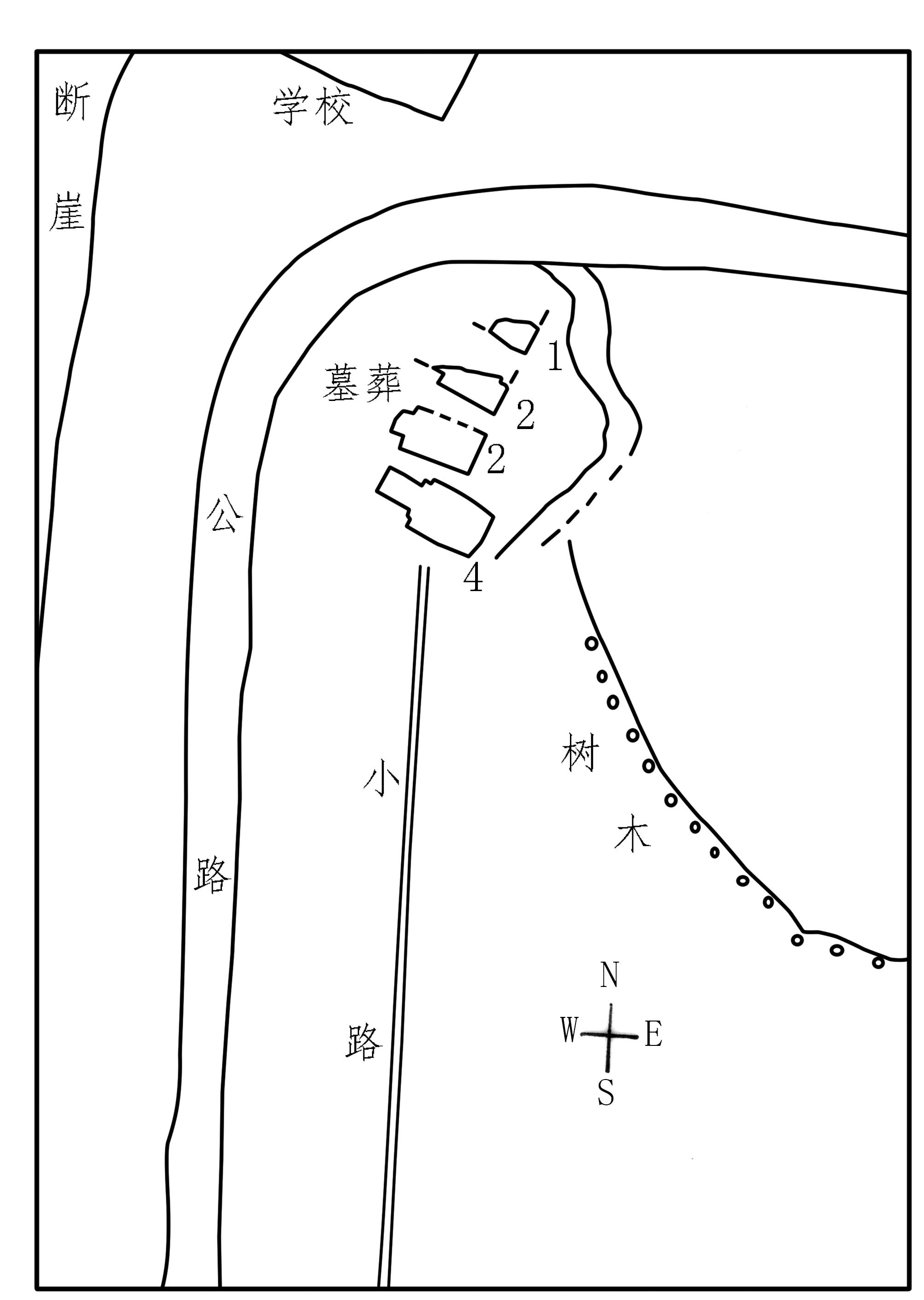
图1 在重庆中学发掘的位置图。这里原来有四座花纹砖墓,其中三座已被修路工人破坏,第四座墓在数百年前也已经被盗。
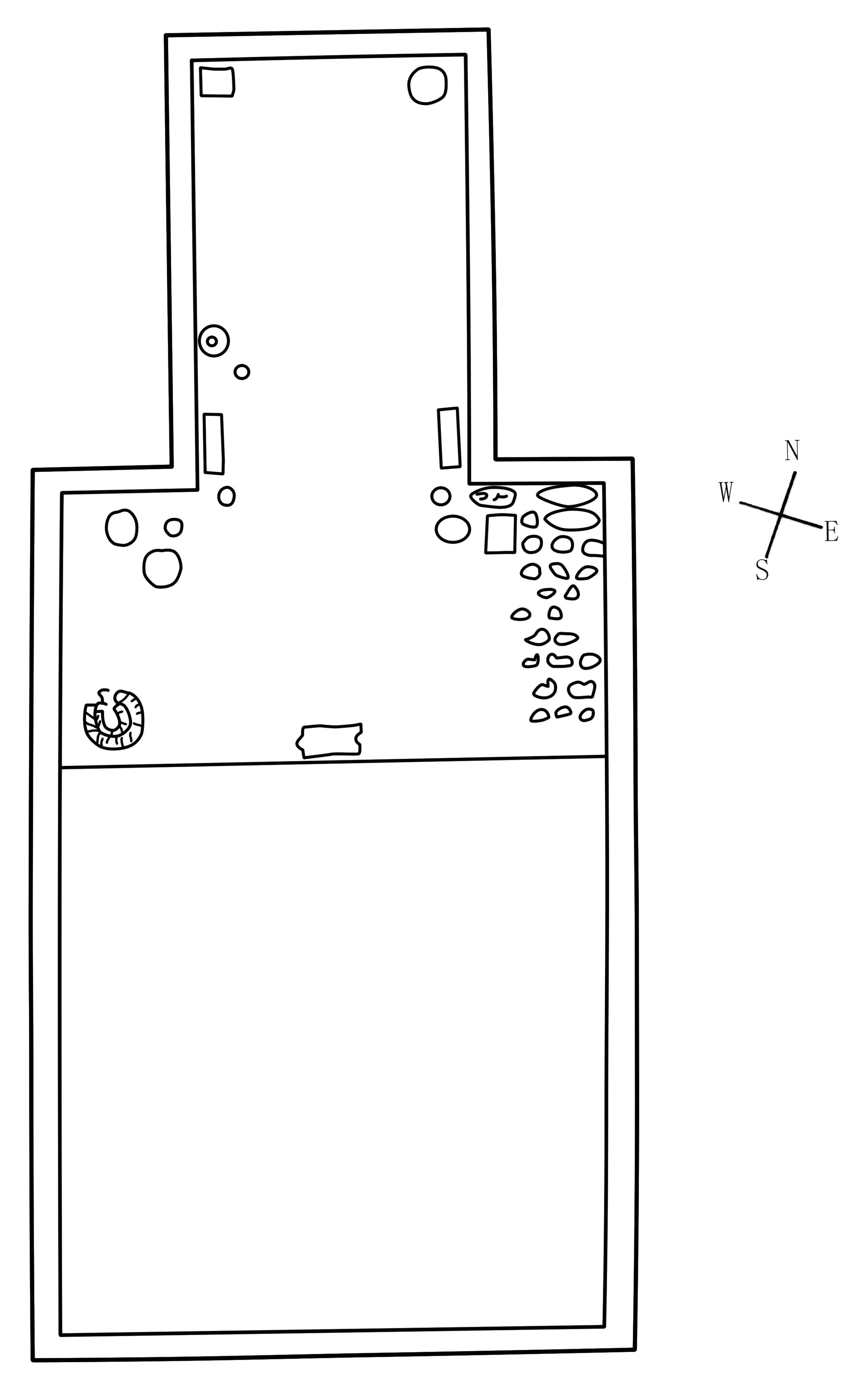
图2 4号墓出土器物位置平面图。在墓室的西南部,从墓道前端开始,依次放置有一件陶鱼塘模型、一件底部饰绳纹的小口圜底灰陶瓮、一件小陶碗、一件两层小陶房、四件陶碗、约两千枚铜钱。在墓的东北部,依次摆放着一件口大底小的圆形灰陶碗、一件屋檐上翘的陶房、两件陶碗、两件橙黄色陶狗、一件橙黄色陶猪、两件重叠放置的灰陶案、陶案中间有六件椭圆形小陶碗以及很多橙黄色陶俑,近墓室中部有一块花纹砖。
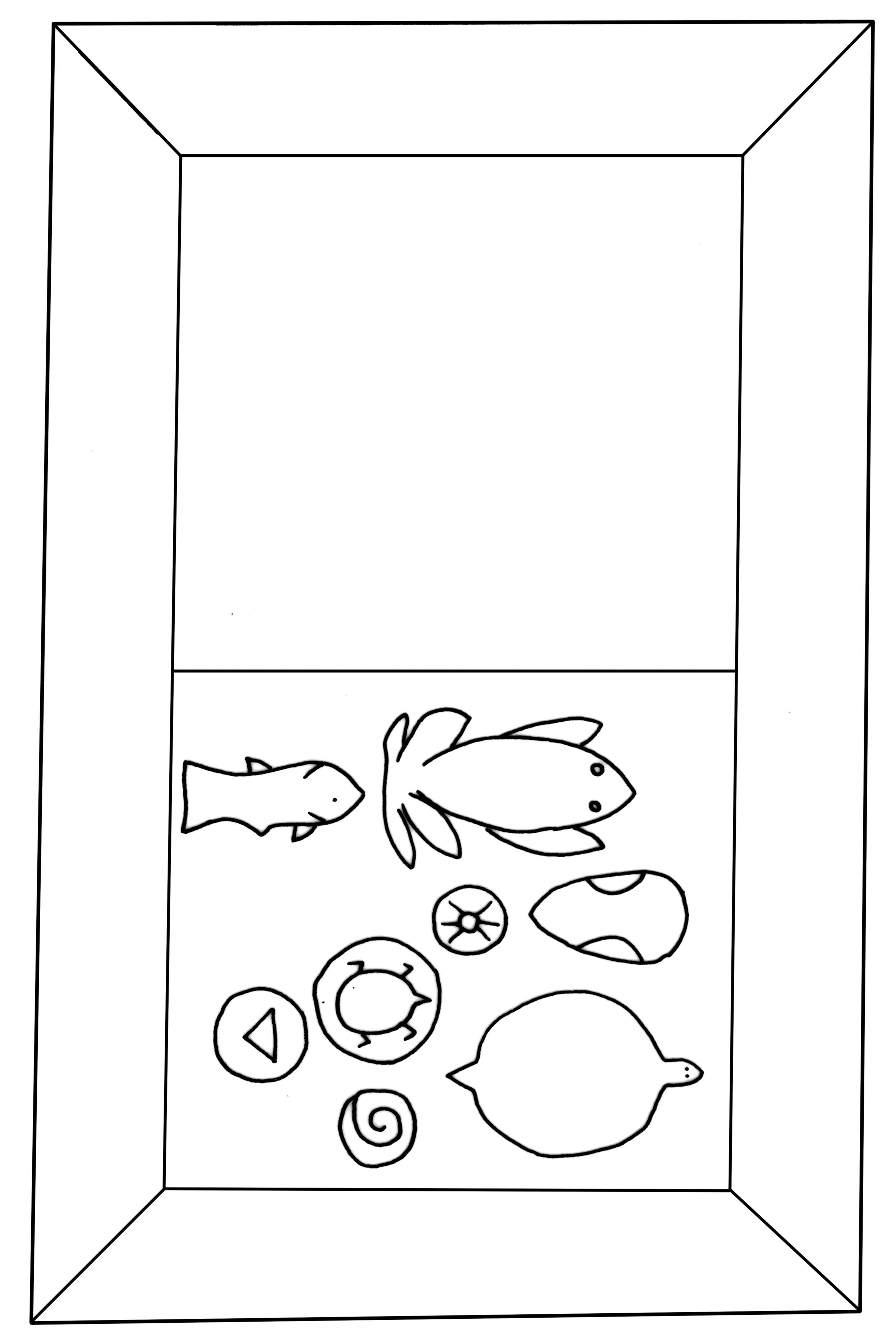
图3 4号墓墓道发现的灰陶鱼塘图。里面有一条鱼、一只青蛙和乌龟、一只蜗牛、一只水甲虫、一朵花(?)、一只正在潜水的鸭子(?)、一件圆圈里不可识别的物体。长418毫米,沿宽44毫米,高43毫米,宽287毫米。

2. 4号墓出土的一件单层陶房图。屋檐上翘,有两根柱子。长422毫米,宽178毫米,高20毫米。这类陶房是用来作为死者灵魂的居所。
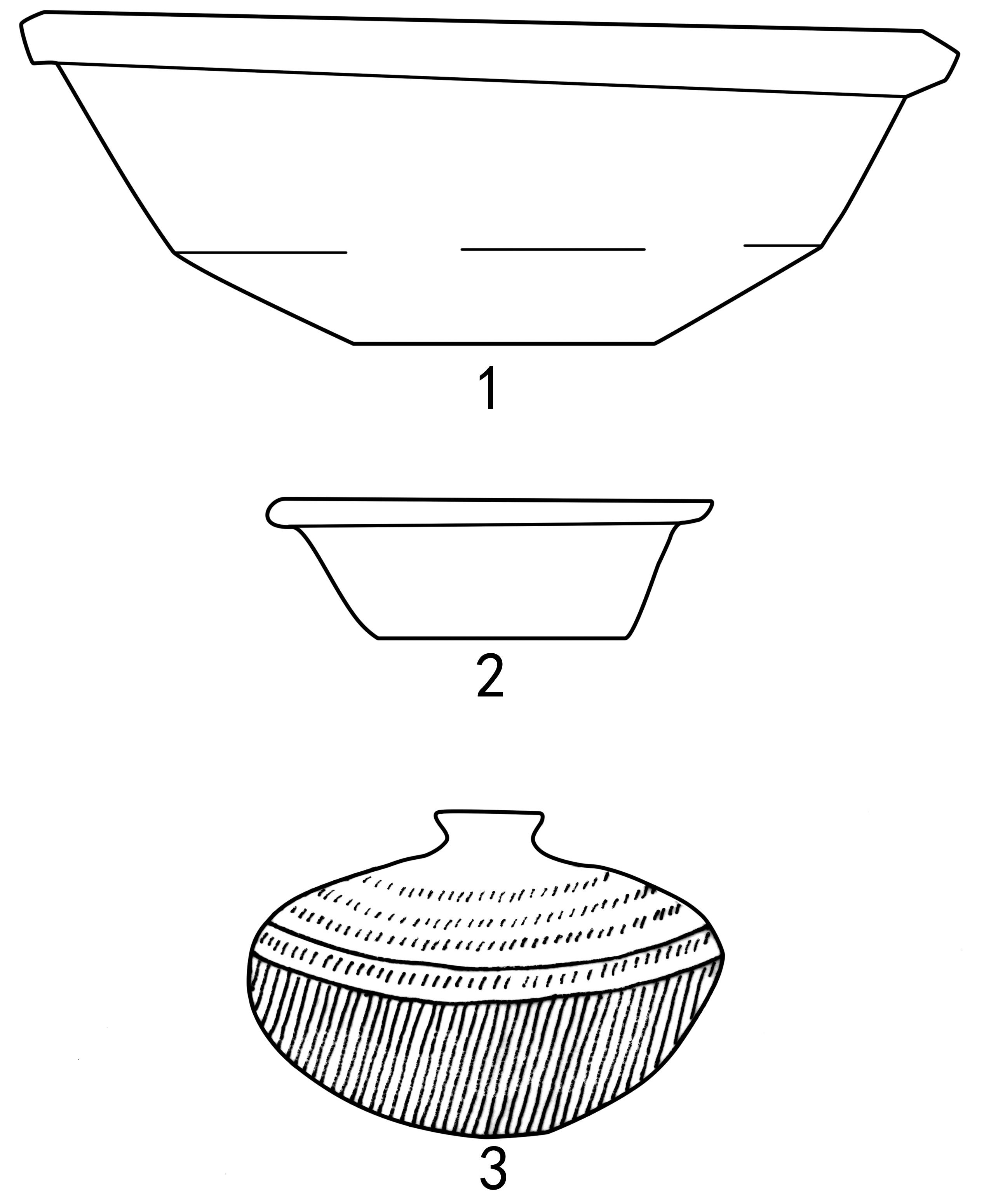
2.4号墓墓道西北角出土的灰陶碗,高135毫米,口径347毫米,底径227毫米。
3.4号墓出土的灰陶瓮,圜底,上部装饰绳纹,高196毫米,口径112毫米,最大直径310毫米。
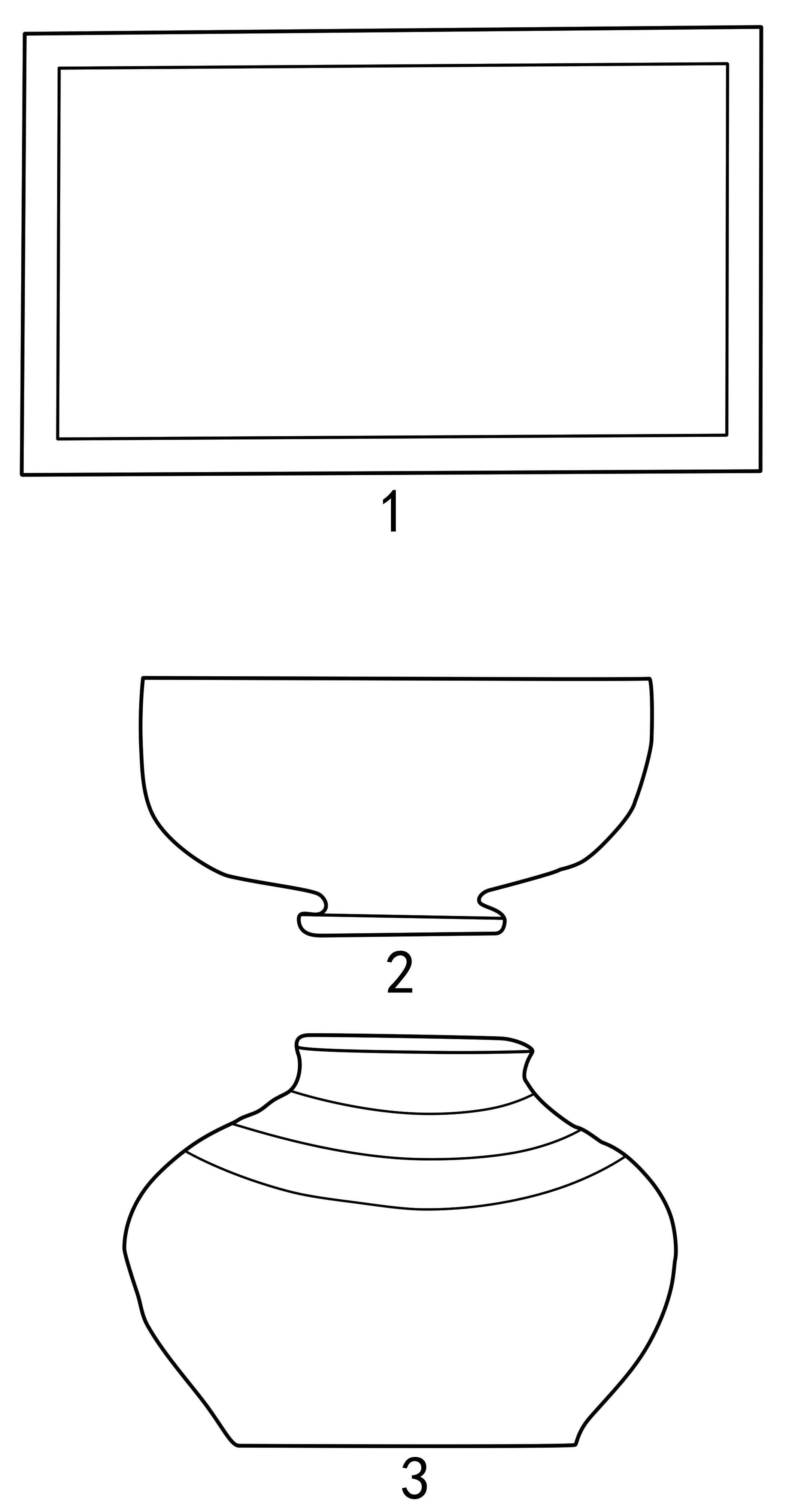
2.出土于同一座墓的一件灰陶碗,高87毫米。
3.出土于4号墓的无把灰陶罐,高60毫米,口径98毫米,最大径188毫米,底径132毫米。
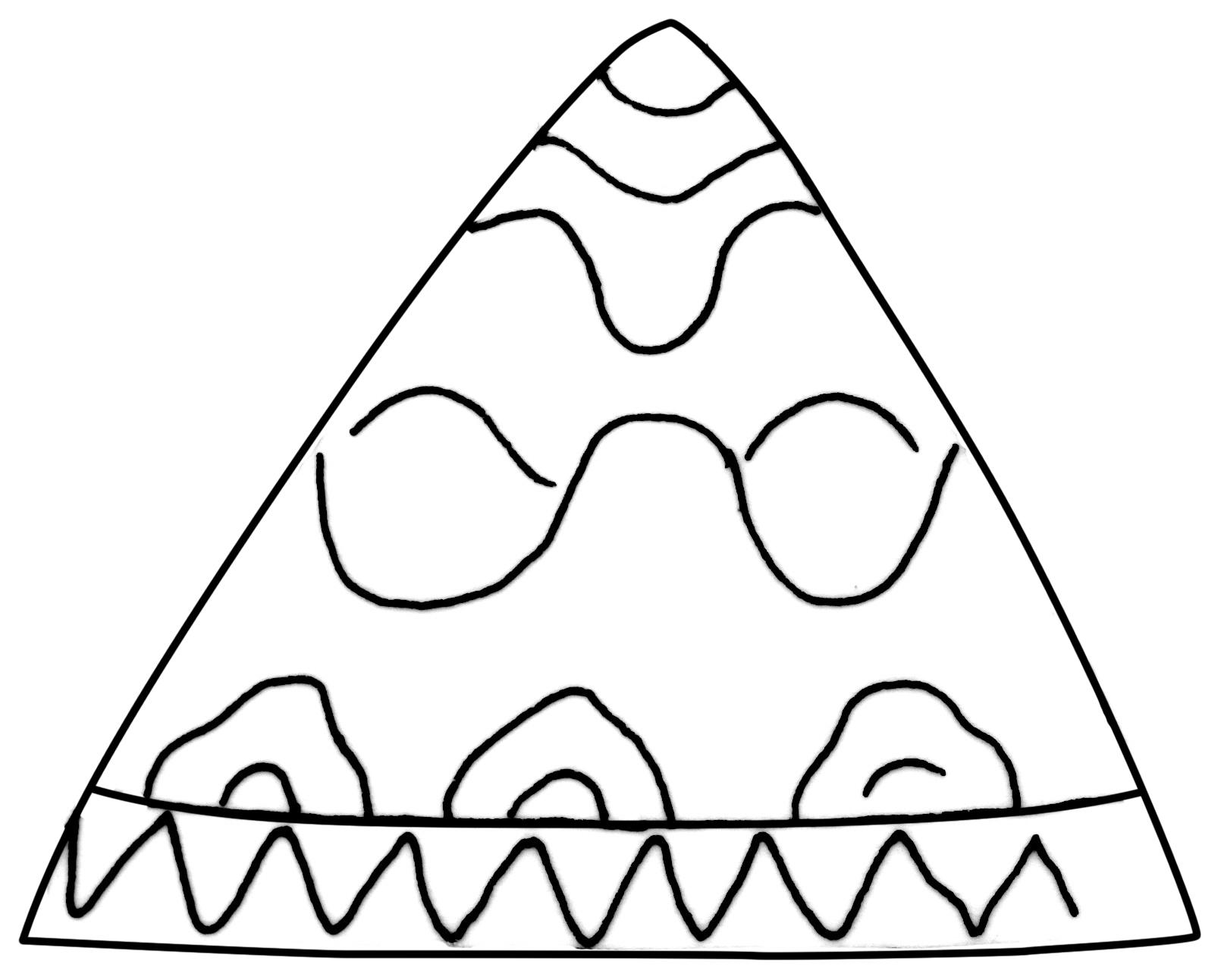
图7 出土于4号墓的一件锥形陶碗盖,器表施黄橙色釉。此前,这种在器表施黄釉的汉代陶器在四川未被发现过。
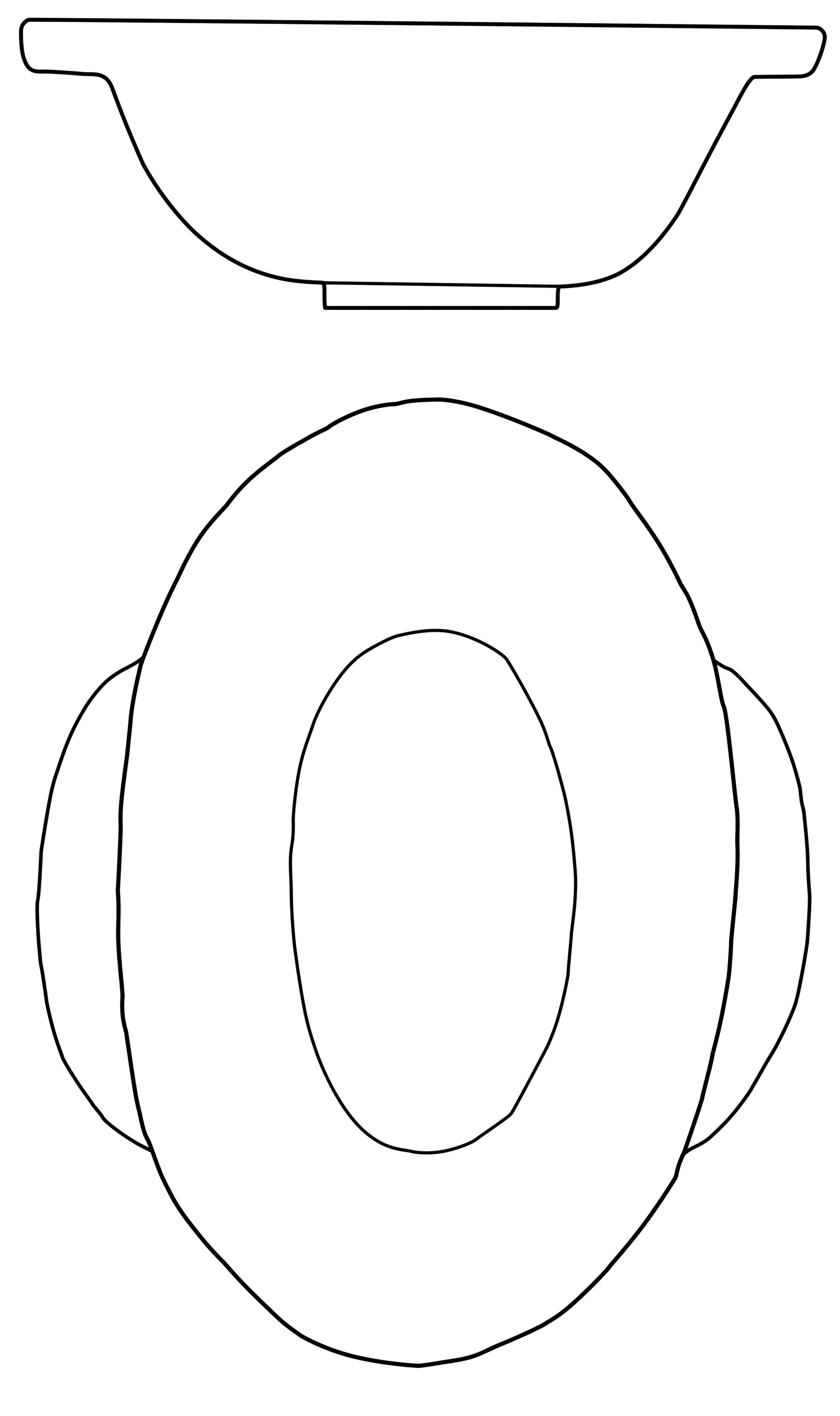
图8 出土于重庆墓葬4号墓的椭圆形无釉灰陶碗的俯视图,器身长115毫米,宽90毫米,口沿厚7毫米,器身厚2-4毫米。这座墓出土好几件同样的碗,较大的一件陶碗长138毫米,宽108毫米,高35毫米。

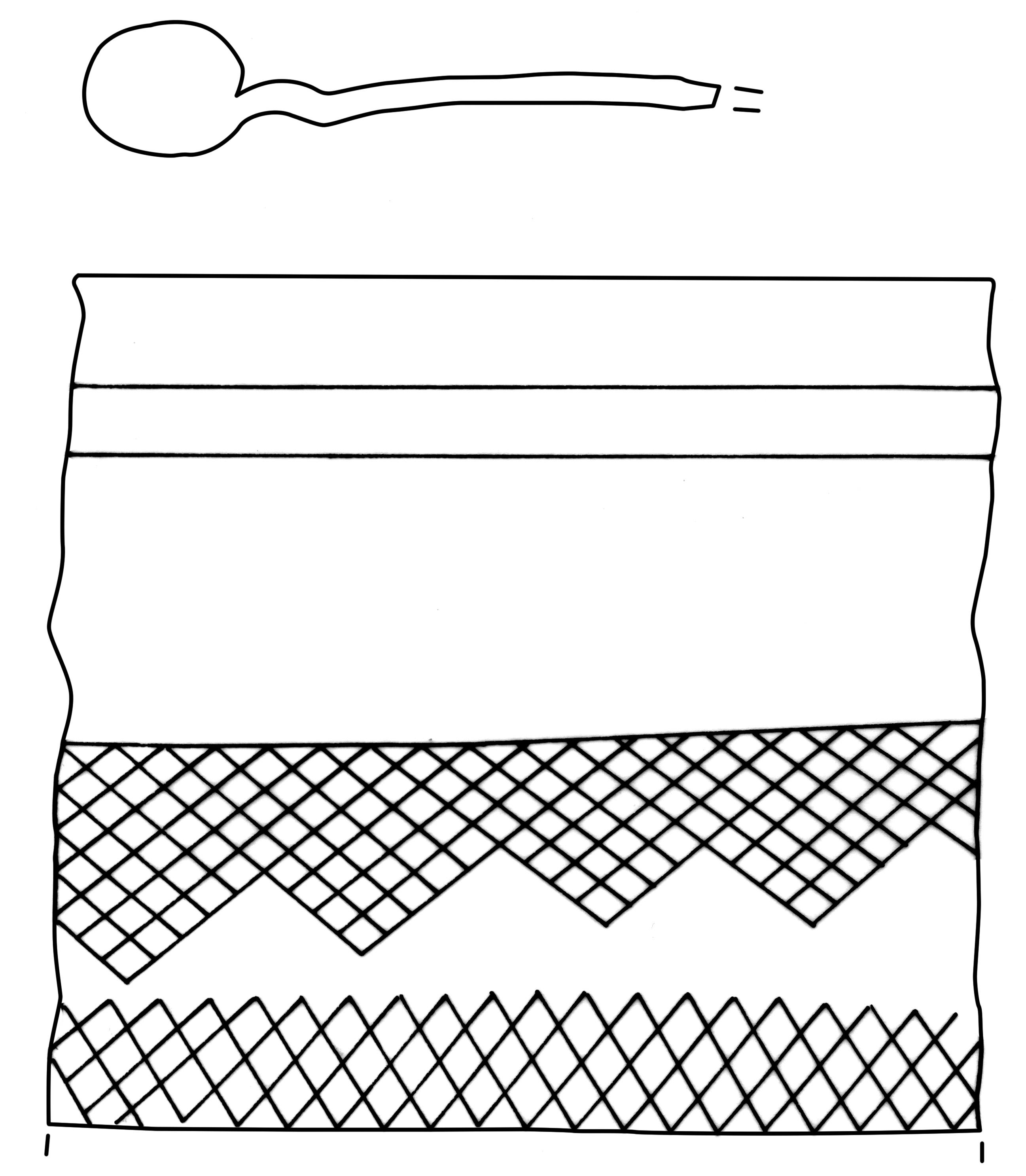

图11. 出土于重庆中学汉代墓葬的陶器口沿残片。
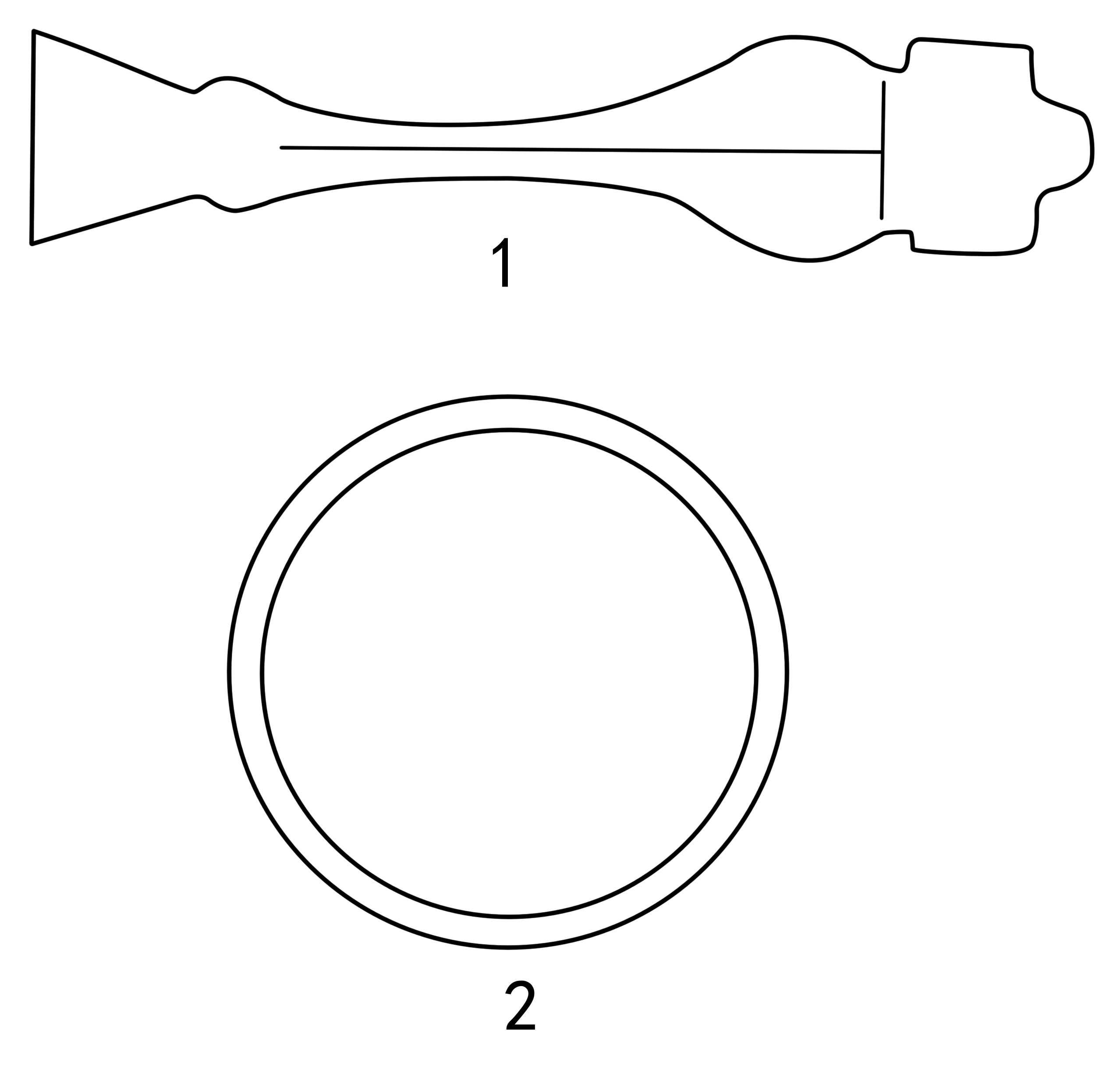
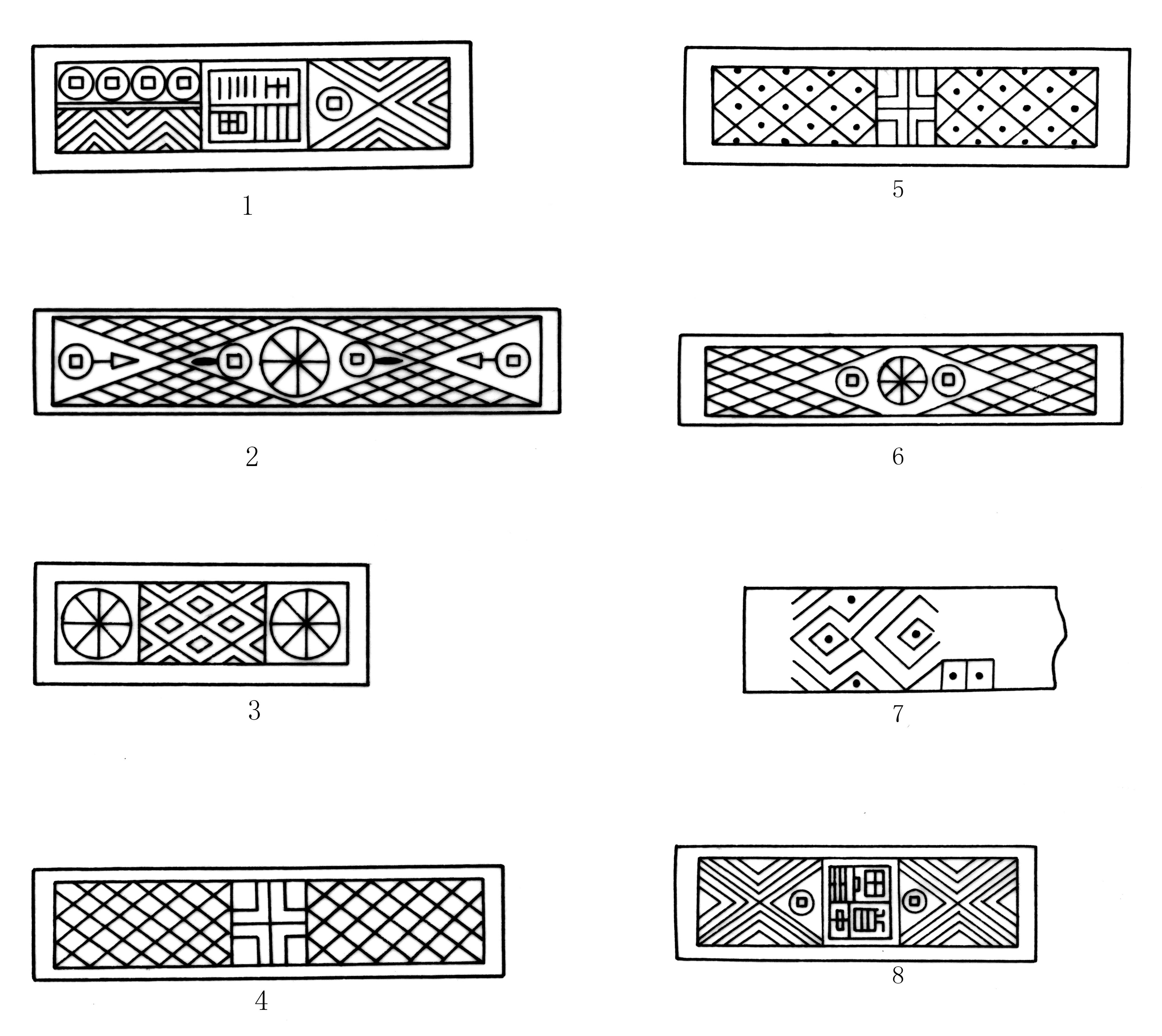
图13a. 重庆中学发掘的中国汉代墓葬出土的墓砖。见图13b、13c。
1. 楔形榫卯砖,砖面长15英寸,宽4¾英寸。砖的一边相对于另一边要短,这样可以将墓顶券成拱形。
3. 4号墓出土的楔形榫卯砖,砖面长11½英寸,宽4英寸。
4. 长方形砖,砖面长17¼英寸,宽4¼英寸,这种砖用于墓底铺地和砌墓壁。
5. 长方形砖,砖面长17¼英寸,宽4½英寸。
7. 长方形砖,发现于墓地附近,残,长度不详,宽8½英寸,厚3¾英寸。
8. 楔形榫卯砖,砖面长14英寸,宽5英寸。
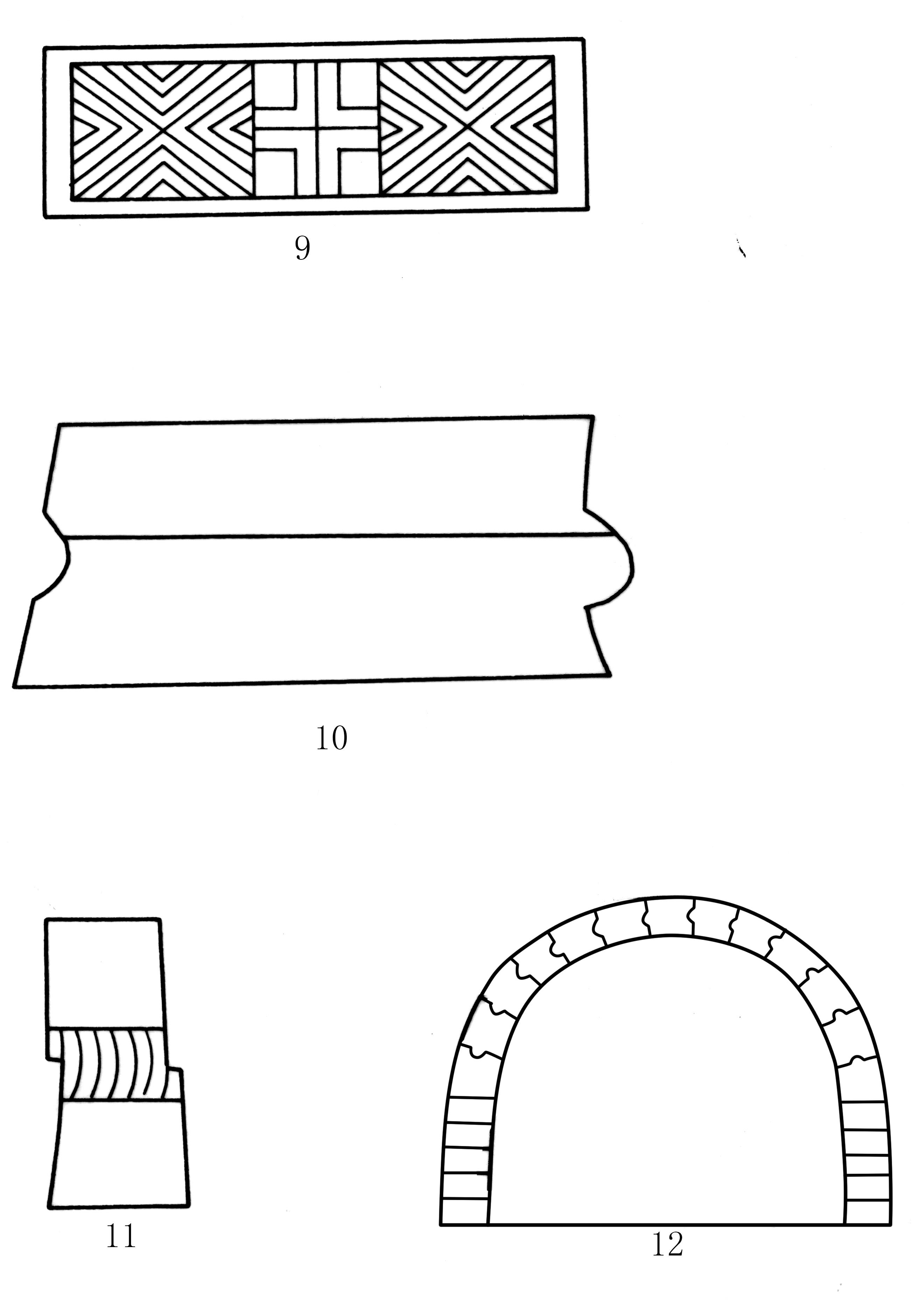
图13b. 9. 楔形榫卯砖,砖面长15英寸,宽4英寸。
10. 墓砖侧视图,最大长度17英寸,宽8英寸,最小长度16英寸。
11. 图13b-9墓砖的剖视图,宽3英寸。
12. 重庆发掘的花纹砖墓的横截面图。
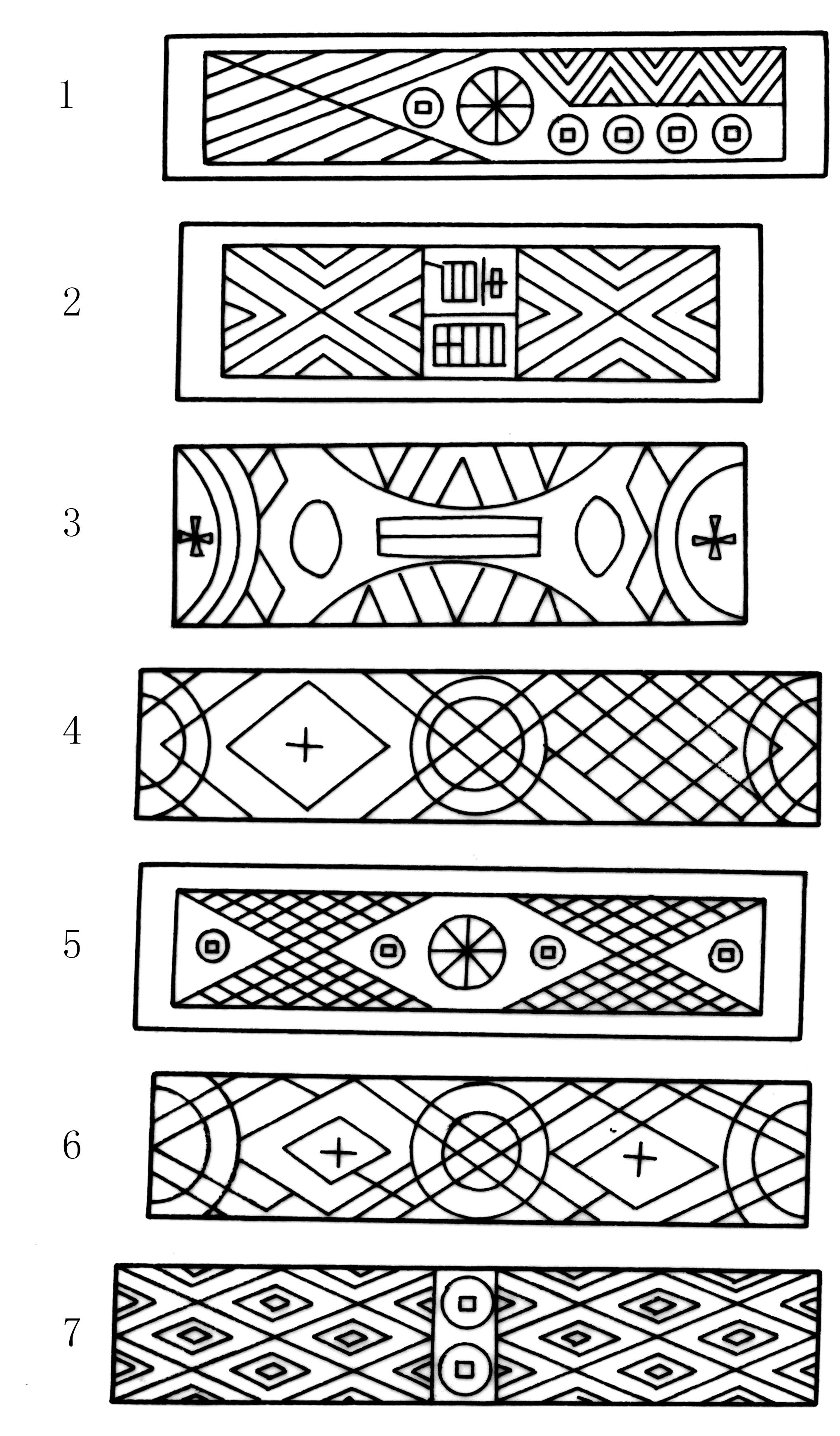
图13c. 在重庆生生公司发现的中国汉代墓葬的花纹砖
1. 长方形花纹砖,饰三角形纹、钱纹和车轮纹,长16英寸,宽8英寸,厚3英寸。
2. 楔形榫卯砖,砖面中间的“富贵”纹表示财富和荣誉的意思,长14¾-16英寸,宽9英寸,厚4英寸。
3. 楔形榫卯砖,面长14½英寸,最大长度为16¼英寸,宽8½英寸,厚(面宽)4¼英寸。
4. 长方形砖,长17英寸,宽8¼英寸,厚(面宽)3¾英寸。
5. 长方形砖,长17英寸,宽8¼英寸,厚4英寸。
7. 长方形砖,饰钱纹和菱形纹,长17¾英寸,宽度不详,厚3¼英寸。

图14. 重庆长江南岸附近的中国汉代墓葬出土的花纹砖
2. 楔形榫卯砖,出土于小龙门浩。正面长12英寸,宽4英寸,两端框边宽1英寸,侧面宽英寸,正中的方形宽2¾英寸,砖长12-15英寸,整块砖宽7¾英寸,正面厚4英寸,反面到正面为4¾英寸,钱币纹中间的两个字“五十”。
4. 楔形榫卯砖,发现于重庆长江对岸的田头口或田里塘的一座中国汉代墓葬,正面长12英寸,宽4英寸,两端边框宽1英寸,侧面宽¾英寸。
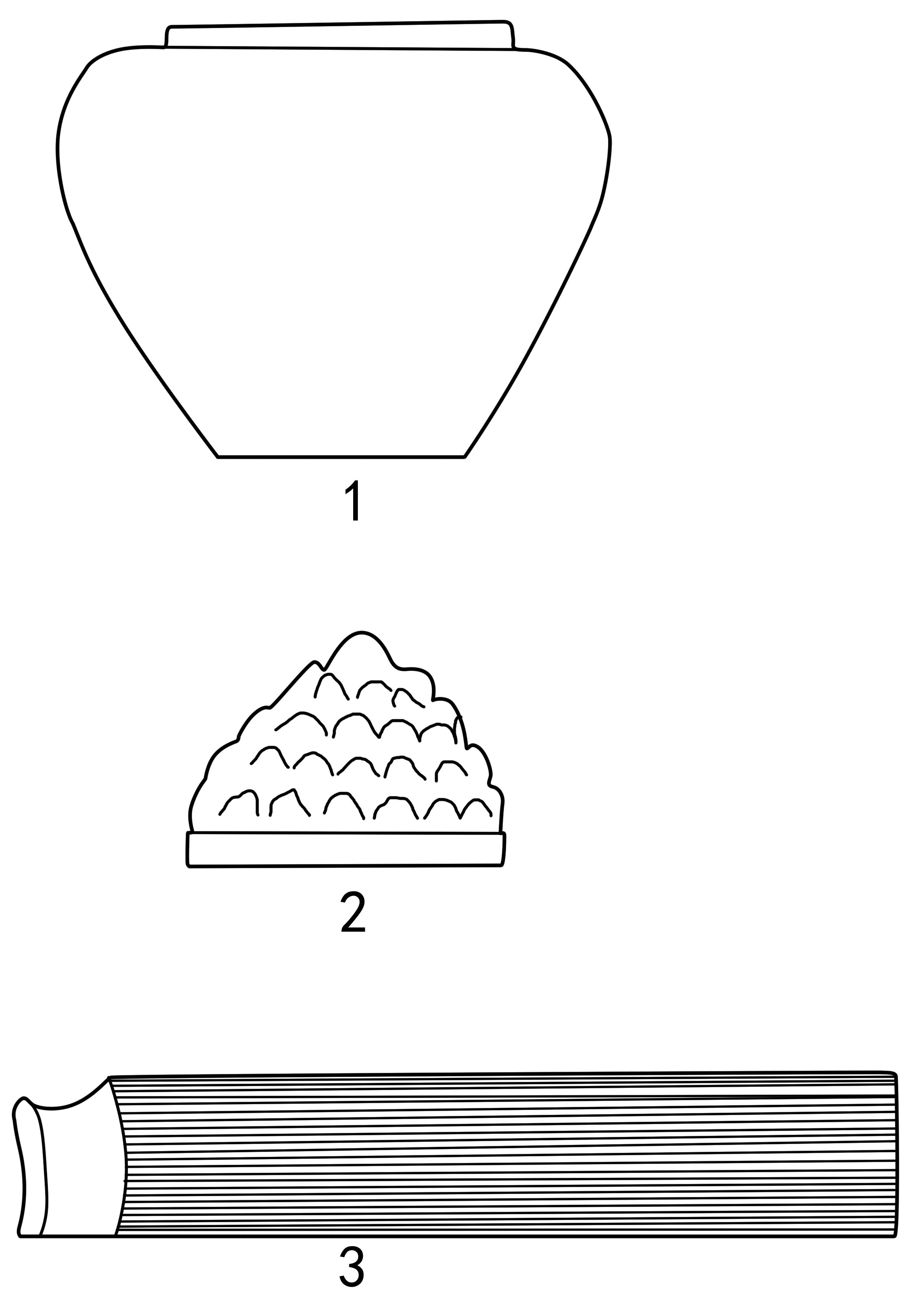
图15. 修路工人在1号、2号、3号墓里发现的三件器物
1. 橙黄釉陶碗,下侧有一道绿釉纹,高120毫米,最大径172毫米,口径99毫米,底径76毫米。
2. 上述陶罐的盖子,施黄绿釉,严重风化。
3. 绳纹灰陶筒瓦,长410毫米。
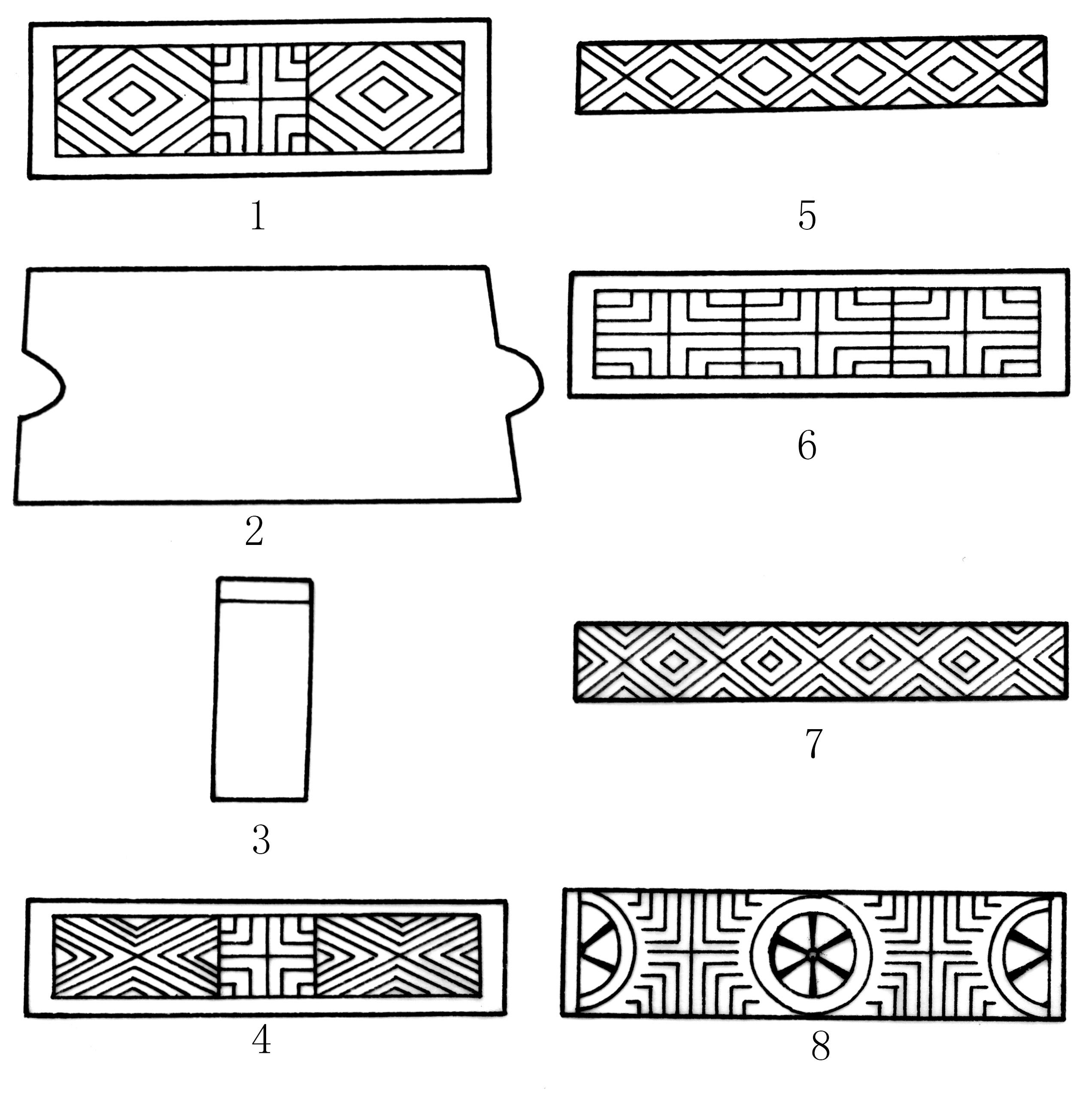
图16. 1932年8月,作者拜访了万县石油公司的经理A. L. Lorensten先生。不久前,Lorensten先生安排工人在石油公司挖掘建筑地基,期间他们发现了一座用大型花纹砖修建的中国汉代墓葬。墓中发现有一把剑,一些汉代钱币,一件“新石器时代”的石斧,一件典型的汉代无釉灰陶。Lorensten先生向华西协和大学考古博物馆捐赠了六块上图所示的花纹砖。
1. 编号C/1014,榫卯砖,长340-362毫米,宽165毫米,厚115毫米。
2,3. C/1014号砖的侧视图和端视图。
5. 编号C/1012,楔形榫卯砖残块,长度不详,宽172毫米,厚60毫米。
6. 榫卯砖,长335-376毫米,宽156毫米,厚90毫米,编号C/1015。
7. 编号C/1013,楔形砖,长度不详,宽182毫米,厚57-78毫米。

Excavation of a Han Dynasty Tomb at Chungking
David Crockett Graham
Translated by Lin Bizhong, Yu Guilan
Abstract: In 1936, three brick tombs of the Han Dynasty were found while building a highway in Chongqing. In 1938, the American missionaries, Mr. David Crockett Graham using modern archaeological method to clean them up, and unearthed a number of cultural relics. From now, the excavation equipment is relatively simple, the working method is not too rigorous, and the unearthed cultural relics are not rich. However, this should be the beginning of the archeological excavation in Chongqing, which is of great historical significance; There are corresponding descriptions and discussions of the huge destruction of Han Dynasty tombs by civil engineering which can be a reference for contemporary cultural relics protection work in cooperation with infrastructure.
Keywords: Chongqing Middle School; Han Dynasty tombs; Cliff-tomb; Tomb Robbers; Excavation; Exploration Site; Glazing; Pottery Figurines; Ornamented Brick; Mortise and Tenon Brick
后记:本文原载于1938年出版的《华西边疆研究学会杂志》第10卷第185页起。原文无摘要及关键词,本次翻译出版时译者添加了摘要及关键词。
EXCAVATION OF A HAN DYNASTY TOMB
AT CHUNGKING
David Crockett Graham
In July, 1936, it came to the attention of Rev. C. B. Rape that some laborers who were making a motor road on the grounds of the Chungking Middle School, of which Mr. Rape is missionary-in-charge and Mr. Yang Chung His杨重熙 is principal, had torn open three ancient Chinese tombs made of ornamented bricks typical of the Han dynasty. The tombs contained glazed images of men, women, dogs, pigs, houses, tables, etc., and glazed and unglazed bowls or jugs. As soon as Mr. Rape heard about it, he stopped the digging in the tombs and endeavored to secure and preserve the objects.
In December 1936, while passing through Chungking, Mr. Rape showed me the bricks and other objects from the tombs, and me made an agreement that as soon as possible I should return and excavate the tombs.
On March 28, 1938, I returned to Chungking and was entertained in the home of Mr. and Mrs. Rape. Next day, with the help of a school servant and some hired coolies. I staked off the site into five-foot squares and began the excavation. The tombs were almost parallel and were on the top and north-east side of a hill that sloped from the south-west to the north-east. They were made of large bricks ornamented on one side, and the bricks on and near the top were doubly dove-talled together and shorter on one side than on the other so that the tops of the tombs wee true arches. The ornamented faces of the bricks were on the inside of the tombs, which consequently presented a very attractive appearance.
On the top of the hill is a layer of red clay less than three feet thick, under which is red sandstone which is more or less escaped and decomposed near the surface. The tombs had been dug down through the clay into the sandstone and covered over on top so as to be invisible.
There were many Han dynasty Chinese tombs in Chungking and recently many have been destroyed. The coming of over a hundred thousand refugees into the city, has resulted in a building boom. This has caused the destruction of many Han dynasty Chinese graves. There is an empty Han dynasty cave-tomb under the Canadian Mission hospital. Several years ago I saw some Han dynasty Chinese cave-tombs that were being destroyed by the construction of the new motor-road to Chengtu, and during this visit I saw several more being destroyed by the widening of the same road. Mr. Rape and I saw the brick from three Han dynasty Chinese tombs on the property of the Sheng Sheng Company 生生公司. A Chinese military official, Mr. Liao, built part of his new house with ornamented bricks from Han dynasty Chinese tombs that were destroyed on this ground, and plastered over the bricks so that the ornamented surfaces could not be seen. Several Han dynasty ornamented brick tombs were recently destroyed on the south side of the Yangtse River from Chungking. Some policemen who came to see the excavation said that many similar graves had recently been destroyed in Chungking, but that nobody appreciated their value, so that nothing was preserved.
Our tools were the surveyers’ level and measuring rod, the plane table, shovels, picks, coarse and soft brushes, sharpened chopsticks instead of orange sticks, a steel tape, etc. Each stake was gives a number, and each square was given the number of the stake on its lower right-hand corner. A map was drawn, and the level at the base of each stake was taken and recorded before the evocation began. Each object was given a field number, and was record with its number, depth, location, and other observations in the field note book. An ideal datum plane was eastablished, from which all depths were computed. The aim was to preserve the materials and all the observations that would aid in the interpretation of the materials.
In one respect the work was disappointing. The first three tombs had been entirely emptied of their contents, and not enough brick had been left in place in the first tomb to tell its size or the location of its mouths. More brick were left in place in the second and third tombs. The fourth tomb had been discovered by the laborers who made the road, but at some previous time the top had been torn off by the farmers, so that rain-water had constantly run into the tomb kept the objects in it water-soaked. As a result the earthenware objects in it were so fragile and soft that they often broke into pieces even when they were carefully handled. Recent rains caused the dirt in the tomb to be so wet and sticky that it was difficult to walk or to stand and work in it.
Because only the top was missing and it was full of dirt and sand, we entertained hopes, that we would find all the objects where they originally been placed, but we were disappointed. Probably within a few decades of the time when the grave was made, thieves tore a large hole through the northeast corner, entered the tomb, the carried out all the valuable objects and probably the coffins and skeletons. The river sand which they found on the bottom was thrown by them into the southwest end, covering up some pottery, images, and cash which we found in their original positions. The drawing of the tomb shows where the different objects were found.
After the excavation I spent some time repairing the three tombs opened in 1936: --
Three broken bowls made of orange-yellow clay and covered in places by green glaze.
Fragments of a gray earthenware fish pond containing a leatherback turtle, two fish, one frog, and two snails.
Pieces of a low table made of gray earthenware.
Pieces of a low table made of gray orange-yellow clay.
Two grey earthenware hoofs and a piece of a leg of a horse.
Two pieces of gray, cord-marked tile or drainage pipes.
Orange-yellow fragments of men.
Two glazed bowls of orange-yellow clay.
One large and one small eliptical bowl with ridges on each side.
A gray earthenware images of a pig , length 236 millimeters, width 236 millimeters.
Legs and other pieces of a dog made of orange-yellow clay.
A plate, the upper surface covered with green glaze.
A gray earthenware dog, flat nosed, tail curling up over its back, a band about the chest and one around the neck meeting at the back of the neck where a leash is tied with which to lead the dog. Length 260 mm, height 213 mm.
The base of a stem bowl covered with greenish-yellow glaze.
The following objects were secured by excavation. All but the first two were found in the fourth tomb:--
A poorly-made smooth-stone implement. It was found in the debris thrown out of one of the tombs by the road-diggers. Tit is the third of the kind that I have known to come out of a Han dynasty Chinese tomb. One was found in an ornamented brick tomb on the Standard Oil Company’s compound at Wanhsien 万县, and one in a cavetomb at Pan Pien Chieh 半边街 near Pengshanhsien 彭山县. I have no idea why they were put into the tombs.
A rock that was not originally in a tomb, and may be a peleolith. It has a cutting edge and a smooth place at the top that could serve as a hand hold.
A smooth, round ,gray handleless bowl larger at the top than at the bottom. It was in the north-east corner of the entrance or passage-way of the tomb.
A small gray-clay fish pond containing a leatherback turtle, a fish, a frog, a flower, a duck in the act of diving (?) etc. The duck and the flower were partly colored red.
A large bowl of gray pottery, cord-marked, round at the bottom, and with a small opening at the top.
Two small earthenware house of gray clay, one placed on each side of the passageway near the main chamber of the tomb. One was single-storied and the other had two stories. The roof of the one-stories house has upturned ends. Each of the houses has two of the braces which have figured so largely in Chinese architecture from the Han dynasty to the present time. This brace is one of the most common decorative designs in the Han dynasty cave-tombs of Szechwan, another link of evidence that they are Chinese grave.
Two dogs made of orange-yellow clay. Unfortunately their heads broke off with the surrounding dirt when they were excavated.
One pig made of the same material. So far I have mot seen or heard of objects made of this orange-yellow clay in Han dynasty Chinese tombs in other province of China. It may be peculiar to Szechwan and due to the fact that the clay is to be found in Szechwan and the color, which could be called golden-yellow, is attractive.
Rice bowls made of gray clay and larger food bowls of similar shape and of the same material.
Two low tables and fragments of a third table, of gray clay. One of these was above the other with six small bowls between them. The bowls are obal or elliptical with ridges on both sides.
Soft orange-yellow clay images of men and women. Because they were water-soked and the dirt was packed tightly around them, the adhesion of the clay in the object was sometimes not so great as that of the clay in the object and the surrounding clay. About half the figures were successfully preserved. One servant was ambitious and wished to help, so he dug out several while I was not present, and every one was spoiled.
Several gray clay handleless jugs found in the passageway and in the main room of the tomb.
Three bronze legs of a large bronze vessel. They were removable and evidently dropped off when the looters carried away the bronze vessel.
About two thousand cash. They were bound together into strings and all were wu chu coins, date 9-23 A. D. This indicates that the tomb was made during the time of Christ or nit very long afterward.
One silver bracelet. I surmise that the bodv had decaved so that the bracelet came off easily and was missed in the dark tomb by the looters. Besides the bracelet not a single object was found in the south end of the tomb, but there was dark clay on both sides that was probably decayed clothing and other material from the coffins. No bones or bone fragments were found.
In one jug were some iron objects that had rusted beyond recognition, and some twisted wire ornaments that ere so decomposed that I could not tell whether they were lead, pewter, or silver.
The common kinds of ornamented bricks were used in all four of the tombs. This makes it seem likely that they were erected a comparatively short time apart.
The objects secured and preserved from these tombs are not as numerous as those from the Suifu tombs which I excavated in 1936, but this trip and the excavations made the following definite and worth-while contributions to our knowledge of the Han dynasty Chinese graves and the culture which they represent.
1. The existence of cave-tombs and tombs of ornamented brick side by at Chunking and in other parts of Szechwan, and containing the same objects, furnishes further evidence that both are Han dynasty Chinese tombs, and that the cave-tombs are not man tzu tung 蛮子洞 or aborigine dwellings.
2. It evident that the types of Han dynasty Chinese grave goods found at Suifu, Kiating, Pengshanhsien, and Chengtu are not mere local variations, but are generally distributed over all Szechwan. In fact, they closely resemble the Han dynasty Chinese grave goods in other parts of China.
3. Further light has been shed on the method of constructing Chinese tombs during the Han dynasty. It was formerly known that at that tong well-to-do Chinese buried their dead in cave-tombs carved into the sides of hills in solid rock, and also in tombs of ornamented brick placed on the surface of the ground and covered over with dirt so that it resembled a small hill, a method that sometimes concealed the grave. A third method, described in this paper, and used in the tops or sides of hills, was to dig a pit into the soil and rock. Make the tomb of ornamented brick, then cover the grave with dirt so that it could not be seen.
4. Han dynasty green and silver-glazed pottery has been found in Chinese tombs in Szechwan before, but this is the first time that yellow or yellowish-green glazed objects have been discovered in Szechwan, although they have been found in Chinese tombs in Sian and in other parts of China.
These materials would have been entirely lost had it not been for the cooperation, interest, and efforts of Rev. C. B. Rape and Principal Yang of the Chungking Middle School. It is their plan to completely restore and preserve the fourth tomb, and to make the objects from the tombs the beginning of an archaeological and educational museum to be located in the Middle School.

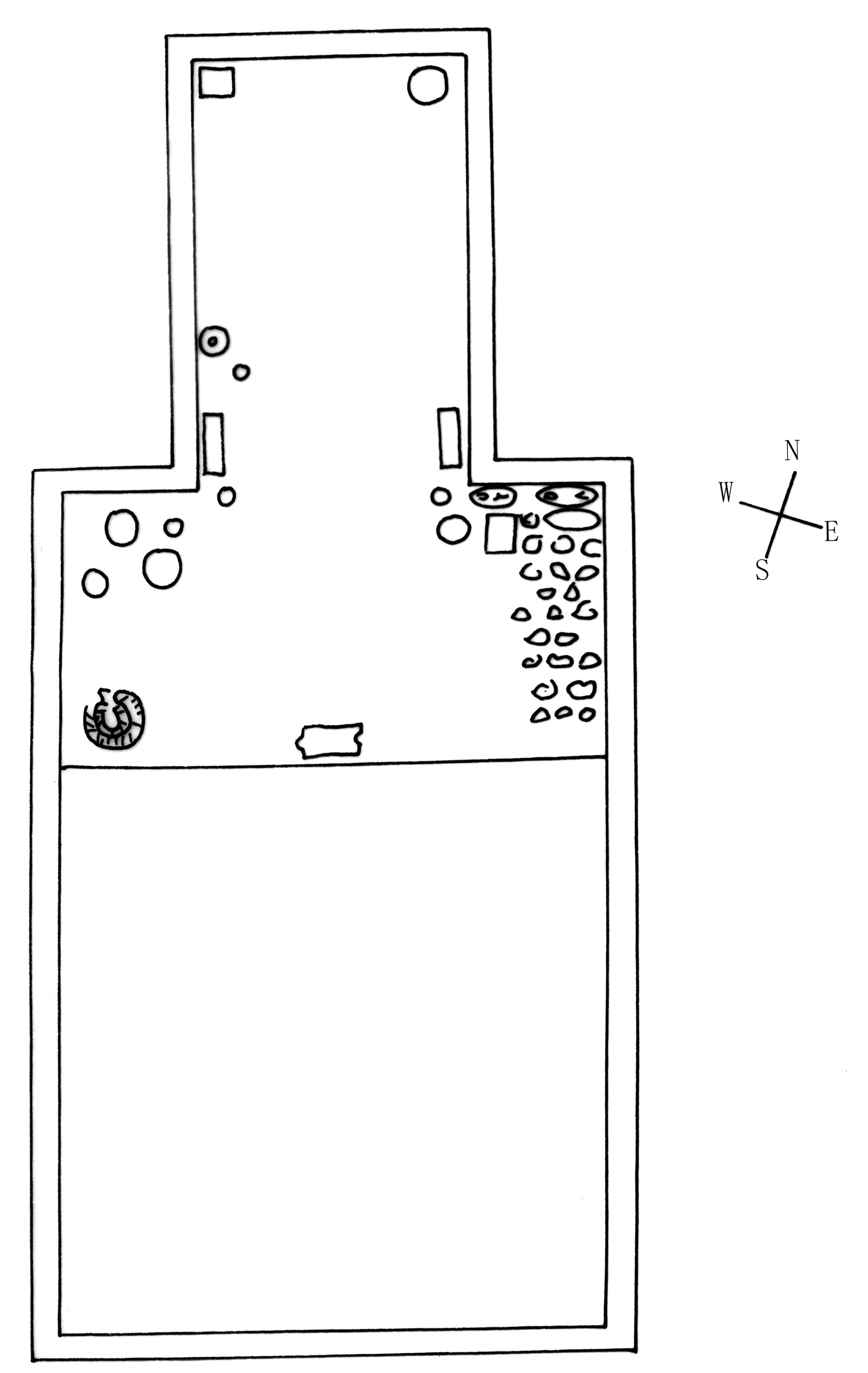
Fig.9. Plan of tomb number 4 showing the location of objects. Those on the southwest side, beginning at the front of passageway are, in order, an artifical fish pond, a gray bowl with a small mouth and a round cordmarked bottom, a small bowl, a small twostorey clay house, four bowls, and about two thousand coins. On the northeast side in the same order are a round gray bowl smaller at the bottom than at the top, a small house with up-turned ends, two bowls, two orange-yellow clay images of dogs, an orange-yellow image of a pig, two small gray earthenware tables one above the other between which were six small elliptical bowls, and numerous orange-yellow images of human beings. Near the center was an ornamented brick.

Fig.10. Drawing of the gray earthenware artificial fish pond found in the passageway of tomd no.4. It contains a fish, a frog, aleatherback turtle, a snail, a water beetle, a flower(?), a duck diving into the water(?), and an unidentified teiangele in a circle. Length 418 mm., width of rim 44 mm., height 43 mm., width 287 mm.

2. Drawing of a one-store house from tomb 4. Note the upturned ends of the roof, and the two braces. Length 422 mm., width 178 mm., height 20 mm. These houses were intended as homes for the souls of the dead.

3. Gray bowl from tomb 4. The bottom is round and mat-marked. The upper part has rope-decorations. Height 196 mm, diam. of mouth 112 mm., maximum diam. 310 mm.

Fig. 13. 1. Top of a low table, gray earthenware. unglazed, from the Han dynasty Chinese tomb number 4 at Chungking. Length 362 mm., width 240 mm., width of rim 17 mm.
3. Handleless jug of gray from tomb 4. Height 60 mm. Diam. of mouth 98 mm. Maximum diam 188 mm. Diam of base 132 mm.

Fig. 14. A conical lid of a bowl from tomb 4. It is covered on the outside with yellow-orange glaze. Han dynasty pottery covered with yellowish glaze had not previously been found in Szechwan.

Fig. 15. 1. End and top view of an oval or elliptical bowl of unglazed gray clay from tomb four at Chungking. Length 115 mm., Width 90 mm., thickness of rim 7 mm., thickness elsewhere 2 to 4 mm. There were several bowls of this size. The dimensions of a larger bowl of this shape are length 138 mm., width 108 mm., height 35 mm.


Fig. 17. Edge and side view of a sherd found in tomb 4. Similar ornamentation is often seen on large Han dynasty earthenware bowls.



Fig. 20a. Bricks from the Han Dynasty Chinese graves excavated on the grounds of the Chungking Middle School. See fig. 13b and 13c.
2. Flat brick. Length 18 inches, width 8½ inches, thickness 3½ inches.
3. Double-bevelled brick from tomb 4. Length of face 11½ inches, width 4Inches.
4. Flat brick. Length of face 17¼ inches, width 4¼ inches, flat bricks were used on the floors and sides of the tombs.
6. Flat brick with wheel and coin designs. Length 17¾ inches, width 8¾ inches, thickness 3¾ inches.
7. Flat brick found near the site, broken. Length uncertain. Width 8½ inches, thickness 4¾ inches.

10. Side of brick, maximum length 17 Inches, width 8 inches, minimum length 16 Inches.
11. End view of brick 9. Width 3 Inches.
12. Cross-section of a tomb made of ornamented bricks as found during the excavation at Chungking.

Fig. 21. Ornamented bricks found in Han dynasty Chinese tombs on the property of the Sheng Sheng Company, Chungking.
2. Face of a double beveled brick. The characters in the center mean wealth and honor. Max. length 16 in., min. length 14¾ in., width 9 in., thickness 4 in.
3. Face of double beveled brick. Length of face 14½ in., max. length 16¼ in., width 8½ in., thickness (width of face ) 4¼ in.
4. Face of flat brick. Length 17 inches, width 8¼ in., thickness (width of face ) 3¾ in.
6. Flat brick. Length 16¾ in., width 8½ in., thickness 3½ in.
7. Flat brick with coin and diamond designs. Length 17¾ in., width (broken ) , thickness 3¼ in.

1. Flat brick from Hsiao Lung Men Hao, Chungking, now owned by Mrs. McCartney. Length 17 Inches., width 7In., thickness 4 in. Central square 2½ in. wide, rim one inch wide.
3. Face of double dove-tailed brick found at T’an Tsu K’ou or Tien Li Ts’ang, across the Yangtse river from Chungking. Found in a Han dynasty brick tomb. The characters in the middle are fu and kuei, meaning wealth and honor. Length of face 14 inches, width five inches.

1. An orange-yellow glazed bowl with a streak of green glaze down its side. Height 120 mm., maximum diam. 172 mm., diam. of mouth 99 mm., diam of base 76 mm.
3. A gray cord-marked tile. Length 410 mm.

Fig. 24. In August, 1932, the writer visited the home of Mr. A. L. Lorensten who was then agent of the Standard Oil Company in Kwanhsien. A short time before this Mr. Lorensten had ordered laborers to dig the foundation of a building on the residence compound of the Standard Oil Company, and in doing so they unearthed a Han dynasty Chinese grave made of large ornamented bricks. In the tomb were found a sword, Chinese Han dynasty coins. a “neolithic” stone axe, and typical gray unglazed Han dynasty Chinese pottery. Mr. Lorensten kindly gave six of these bricks to the West China Union University Museum of Archaeology, drawings of which are shown above.
4. Double-bevelled brick, max. length 415 mm. min. length 375 mm., thickness 108 mm., width 214 mm. No C/1010.
6. End-bevelled brick, Max. length 376 mm., min. length 335 mm., width 156 mm., thickness 90 mm. No. C/1015.
7. C/1013. Keystone shaped brick. Length uncertain. Width 182 mm. Max. thickness 78 mm., min. thickness 57 mm.
8. C/1011, a flat brick, length 16 in, width 7 In., thickness 4¼ in.

Fig. 25. Drawings of a sherd of a black vase, temmoku, and a reddish temmoku pitcher found in the Sung dynasty kiln site at Huang Ko Ya, near Chungking.










 重庆考古
重庆考古